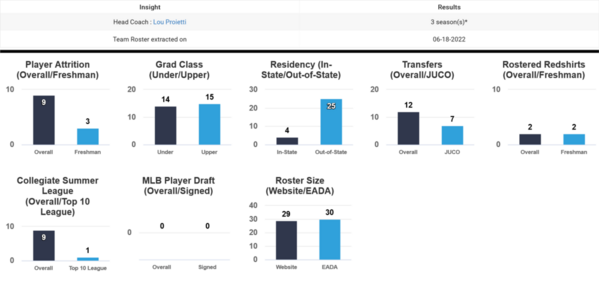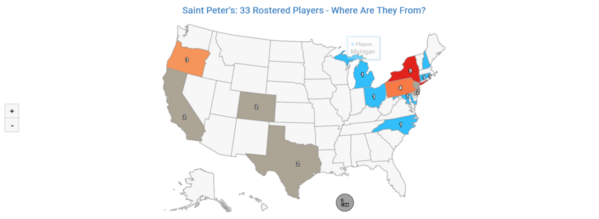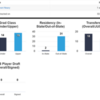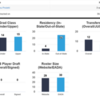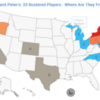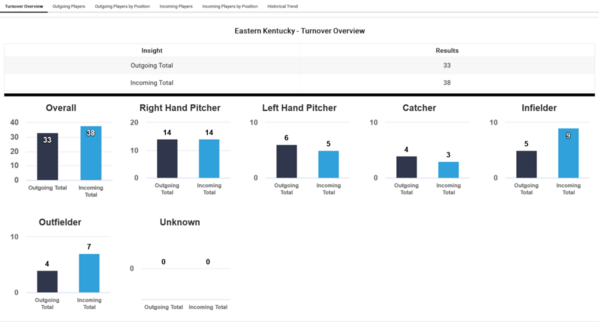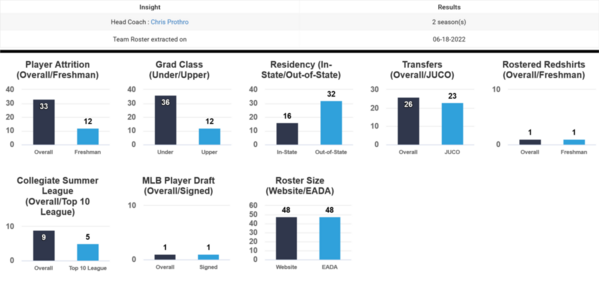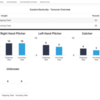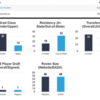I know the NCAA was concerned about early verbal commits, so they updated the rule to prevent it from happening. Is there any way the NCAA can address programs that are over recruiting and cutting/dropping a bunch of kids before the spring season?
Replies sorted oldest to newest
Great question. Will be interested to hear. I am going to be very interested to see how seniors will be recruited (if at all by d1s in the next few years) Son is a 2027. Obviously with moth schools recruiting out of the portal it is going to make things very tough.
NCAA looking out for college athletes? I don't think they're allowed to do that.
Jokes aside - there is nothing "wrong" with over recruiting and cutting kids. At the end of the day it is up to the student athlete to make an informed decision.
There is nothing "wrong" with a coach telling a player that they don't see him getting a ton of playing time and if he wants that he is better off transferring.
It's morally wrong, there are no rules against it.
Short Answer - No
Medium Answer - No, and they shouldn't
My feeling is college coaches should be able to find 18-20 contributors out of 35 players. But it doesn’t work that way at many programs.
If a kid can’t get on the field at a P5 he’s probably not a pro prospect. He should have set his sights lower. A kid who develops into a pro prospect at a mid major still gets a pro opportunity out of college. He can prove he’s a pro prospect in a top summer league.
Even some D3’s have reputations for over recruiting. But it’s a different scam. It’s not about accumulating potential baseball studs. It’s about accumulating full paying students for the university.
A friend’s son told me about 27 players thinking they were arriving at a D3 as preferred walk ons. They reality was the 27 walk ons were competing for 3 roster spots. The team dressed 32 players. At this HA the coach was allowed up to 8 preferred admissions. These 27 preferred walk ons came after the 8 preferred admissions. That’s 35 freshman trying to make a team.
@Momball11 posted:I know the NCAA was concerned about early verbal commits, so they updated the rule to prevent it from happening. Is there any way the NCAA can address programs that are over recruiting and cutting/dropping a bunch of kids before the spring season?
How do you define over recruiting. Obviously there are extremes. Doubt NCAA will ever do anything, and I'm not sure they should.
P5s have guaranteed contracts. Has that prevented over recruiting? On top of that I believe certain conferences have some rules. The Big 10 has something IIRC, I forget the details.
Making families/schools sign NLIs as soon as they "commit" would certainly curtail it.
@nycdad posted:Making families/schools sign NLIs as soon as they "commit" would certainly curtail it.
Yes, this. Why they haven't implemented this is a complete mystery to me. Although no doubt some coaches would still tell their NLI-signed recruits that they wouldn't see the field, and have them de-commit legally.
This site is littered with stories of over-recruiting, for the last 25 years. That's before the 35-man roster, before the P5 "guaranteed" 4 years, before the transfer sit-out year was implemented (and after it ended) etc. In fact, I think that if you google "college baseball over-recruiting" it's HSBBW that comes up first. And that is an article written in 2002!
All sports are games with somewhat arbitrary rules. Rules change, and coaches and players adapt (see: pitch clock, shift).
The fact is that college sports recruiting is itself a game with somewhat arbitrary rules, and coaches adapt to whatever the rules are. Now that the rule is that players can transfer without sitting, the coaches have adapted to that and feeding frenzy ensues. If the rule were that you could only have 35 in the fall and not add any mid-year transfers, coaches would adjust to that, too. Guess what, there would still be competitive baseball games.
The problem is that the coaches are better at working the rules than the recruits are.
@nycdad posted:How do you define over recruiting. Obviously there are extremes. Doubt NCAA will ever do anything, and I'm not sure they should.
P5s have guaranteed contracts. Has that prevented over recruiting? On top of that I believe certain conferences have some rules. The Big 10 has something IIRC, I forget the details.
Making families/schools sign NLIs as soon as they "commit" would certainly curtail it.
Over recruiting to me is bringing in more players than the amount of players that is permissible on that spring roster. So if that's a 40 man roster, then that's all that should be allowed. No bringing in more and trimming down to get the 40.
@Momball11 posted:Over recruiting to me is bringing in more players than the amount of players that is permissible on that spring roster. So if that's a 40 man roster, then that's all that should be allowed. No bringing in more and trimming down to get the 40.
Over recruiting has been going on for decades. It has gotten worse lately because there is currently an over-supply of players. Colleges know this and use it to their advantage in the recruiting process. But the NCAA exists only to protect the interests of their member institutions. They give zero sh$ts about college student athletes. To expect the NCAA to enforce restrictions that don’t favor their member schools is naive at best. And to expect a roster cap that insures every player that arrives on campus makes the team is even more unrealistic. College sports are competition based and the higher you go up the food chain the more competitive it is.
There is plenty of info available to know which schools over recruit. Buyer beware. Tons of players and parents don’t think it can happen to their kid…. until it does.
@RJM posted:Even some D3’s have reputations for over recruiting. But it’s a different scam. It’s not about accumulating potential baseball studs. It’s about accumulating full paying students for the university.
yep! “Dorm Fillers”
This conversation got me thinking about a related topic - the walk-on. I am curious what a P5 walk-on looks like these days - let's call them a preferred walk-on. I know they must exist because of scholarship limits (counters), but I assume these are really good players. Are these essentially recruited players who fail to make the final scholarship cut and perhaps are told they can walk on (i.e. try out) and work towards possible scholarship money the following year, etc? Maybe P5 is not the best example, so any observations on what these folks look like at the next tier? I assume some of the moderate over recruiting is handled by pushing kids from the scholarship bucket to a non-scholarship bucket working towards securing a roster spot.
A related question - should one assume that the "acceptace" of a preferred walk-on offer usually shows up as a commitment on the PG database (understanding this is populated by the player)?
@2017 Lefty Dad posted:This conversation got me thinking about a related topic - the walk-on. I am curious what a P5 walk-on looks like these days - let's call them a preferred walk-on. I know they must exist because of scholarship limits (counters), but I assume these are really good players. Are these essentially recruited players who fail to make the final scholarship cut and perhaps are told they can walk on (i.e. try out) and work towards possible scholarship money the following year, etc? Maybe P5 is not the best example, so any observations on what these folks look like at the next tier? I assume some of the moderate over recruiting is handled by pushing kids from the scholarship bucket to a non-scholarship bucket working towards securing a roster spot.
A related question - should one assume that the "acceptace" of a preferred walk-on offer usually shows up as a commitment on the PG database (understanding this is populated by the player)?
I think a lot of the "walk-ons" defined as, not on a scholarship, are kids that were on scholarship and were talked into taking NIL money instead. Our last home game of the season, I was standing around with a bunch of parents and found out that quite a few (that I never suspected) had been talked into trading their scholarship for equal NIL. It happened to son's roommate his sophomore year and then he was cut after regionals that year.
@2017 Lefty Dad, when considering a walk on offer you should understand that not all offers are equal. To properly evaluate a “walk on opportunity” you need some information that is particular to that school. How are they funded? How many total scholarships do they have to offer? What is their history of over recruiting? What is the need at your position? When those things are known the picture becomes more clear.
Most walk on offers are a long shot possibility of making the roster. Especially today. However, there are many schools that have good baseball programs that are underfunded. Those programs depend on non scholarship players and many of them are on the field regularly. Temple College in NJCAA Region 5 is a good example of what I’m describing. But unless it’s a school like Temple a walk on offer is nothing more than a 90 day tryout and the word “preferred” in front of walk on means absolutely nothing. However it does provide the opportunity for the player to post a commitment on social media and bask in false glory for a few days while all his friends retweet about what a dawg he is.
@baseballhs posted:I think a lot of the "walk-ons" defined as, not on a scholarship, are kids that were on scholarship and were talked into taking NIL money instead. Our last home game of the season, I was standing around with a bunch of parents and found out that quite a few (that I never suspected) had been talked into trading their scholarship for equal NIL. It happened to son's roommate his sophomore year and then he was cut after regionals that year.
Some schools seem to be very creative about getting some of their very good players off of baseball scholarship money and compensated differently. You just described why that is dangerous and not in the best interests of any player. The game seems to be “use scholarship money to get the player to campus and after the first year find a way to get the scholarship back from the player. Move on to the next recruiting class. Rinse and repeat.”
My son will be a preferred walk on to a mid major when he goes there this fall. The coach offered us a choice of athletic money or academic money (they can't stack). The amount is similar. Coach said their university policy doesn't allow them to stack academic on top of athletic later on (after freshman year) if you start out with athletic money, but they can stack athletic money on top of academic later on. For various reasons, we concluded that academic money is best option for my son.
He didn't have to sign an NLI, but he did sign a simple 1-pager with the school essentially saying that the school is guaranteeing him a spot in the team in return for him guaranteeing to enroll in the school. His experience with the school is no different from the kids getting athletic money, including official visit and photo ops for use for the commitment announcement.
His school is not a mid-major powerhouse and has a relatively small incoming class (10 or 11 HS recruits). I know they have at least 1 or 2 coming from transfer portal based on social media announcement posts. Ask me again a year from now and I'll have more details, esp about how my son looks compared to the ones getting athletic money.
The "walk-on" can be tricky. Especially in a state like FL where a kid can get a free ride if they have good grades and qualify for Bright Futures. I saw a private P5 university offer a kid a small athletic scholarship or a full academic but wouldn't stack them. He took the academic money and was cut at the end of the first year. I'm guessing they would have told him to look elsewhere anyway at the end of the year had he taken the athletic money. At the end of the day, if the coach doesn't see you in their long-term plans they will get rid of you one way or the other. I guess one guarantees you a spring roster spot while one guarantees you nothing.
Athletic money doesn’t guarantee a roster spot. If the player with athletic money proves to be a dud in the fall someone else not receiving money could get his roster spot.
Son’s friend said this happened at his Big Ten. Player came in heavily recommended by a former player/alumnus. Said the kid got caught up in the numbers game in California (too many D1 prospects). Coaching staff never saw him play live. The kid got 25%. He showed up in the fall and stunk. He was told in November he wouldn't be part of the program. Son’s friend said it was obvious the first week of fall practice.
@TerribleBPthrower posted:The "walk-on" can be tricky. Especially in a state like FL where a kid can get a free ride if they have good grades and qualify for Bright Futures.
I agree with this. We knew kids who got full state scholarships based on their grades and family income, who then got cut. To the coach, such players are pure experiment - if they work out, great! if not, no big deal. They players would have been much better off going to mid-majors where they would have been developed for a few years.
So I assume most coaches recruit with athletic money up to their limit. And then they add as many walk-ons as they can get to come. And that's where the "over" in over-recruiting comes from.
Man, this is disturbing. Im going to have my son focus on football![]()
Then all you'll have to worry about is CTE.
@Dadof3 posted:Man, this is disturbing. Im going to have my son focus on football
Do you think over recruiting is any different in football. The 2022 Alabama football roster has 119 players listed. There are five QBs listed. They already knew who the starting QB would be.
@Dadof3 posted:Man, this is disturbing. Im going to have my son focus on football
@RJM posted:Do you think over recruiting is any different in football. The 2022 Alabama football roster has 119 players listed. There are five QBs listed. They already knew who the starting QB would be.
Oddly enough it almost is better with football. D1 football had a rule that you could only recruit 25 guys in one year regardless of what the roster looked like and you could never go over 85 scholarships. That was eliminated for two years due to Covid, which is why you see Bama with 119.
Either way football has 85 scholarships for 11 guys on the field at any point. They can afford to swing and miss a lot before it actually becomes a problem. My guess is that they could miss 30 times before it becomes an issue. That number should really be 55 tops, but that is a different conversation.
I know a two sport athlete at a prominent P5 school. His first year was all baseball money, final 3/4 would be all football - done to circumvent the 25 player/class cap and baseball is essentially only giving him a 25% ride for three years of flexibility.
@2017 Lefty Dad posted:This conversation got me thinking about a related topic - the walk-on. I am curious what a P5 walk-on looks like these days - let's call them a preferred walk-on. I know they must exist because of scholarship limits (counters), but I assume these are really good players. Are these essentially recruited players who fail to make the final scholarship cut and perhaps are told they can walk on (i.e. try out) and work towards possible scholarship money the following year, etc? Maybe P5 is not the best example, so any observations on what these folks look like at the next tier? I assume some of the moderate over recruiting is handled by pushing kids from the scholarship bucket to a non-scholarship bucket working towards securing a roster spot.
A related question - should one assume that the "acceptace" of a preferred walk-on offer usually shows up as a commitment on the PG database (understanding this is populated by the player)?
My son was a preferred walk on when he went to Iowa's only P5 five years ago (it seems so long ago, and it seems like yesterday). Coach told us he had committed all of his money from freshman year, but son would get 25% for the remainder of his time there, and no one would know the difference — he would travel, get the same shoes, shirts and other gear as the rest of the team, etc.
There were nine kids in his class, two of whom I never heard of after the announcement, three of whom were in the same preferred walk on bucket. Of the other four, two or three got money but left before graduation. All the guys who were preferred walk ons stayed at least three or four years and left either when they got drafted or exhausted their eligibility.
In my son's last exit interview his coaches did suggest he could probably get more money out of NIL than athletic scholarship, but I'm not sure that was realistic.
Two points — one, five years in college baseball was an eternity ago and I'm sure a lot has changed. Second, Iowa has one D1 baseball program and it's a small state. I think the coaches are very careful about what they promise and making good on those promises because they know it will get harder to recruit if they screw someone over. JMO
@Iowamom23 posted:My son was a preferred walk on when he went to Iowa's only P5 five years ago (it seems so long ago, and it seems like yesterday). Coach told us he had committed all of his money from freshman year, but son would get 25% for the remainder of his time there, and no one would know the difference — he would travel, get the same shoes, shirts and other gear as the rest of the team, etc.
There were nine kids in his class, two of whom I never heard of after the announcement, three of whom were in the same preferred walk on bucket. Of the other four, two or three got money but left before graduation. All the guys who were preferred walk ons stayed at least three or four years and left either when they got drafted or exhausted their eligibility.
In my son's last exit interview his coaches did suggest he could probably get more money out of NIL than athletic scholarship, but I'm not sure that was realistic.
Two points — one, five years in college baseball was an eternity ago and I'm sure a lot has changed. Second, Iowa has one D1 baseball program and it's a small state. I think the coaches are very careful about what they promise and making good on those promises because they know it will get harder to recruit if they screw someone over. JMO
Good stuff. Hope Duncan is doing well.
Sometimes folks here make it sound like every coach is out to screw every player. That is not true.
We all know that not every D1 program is fully funded. That's why I like NIL. Call it what you want to, it has helped a lot of players pay expenses.
If a player accepts a walk on opportunity, for those that don't understand unless you are a stud, your playing time may be few and far between if you have no $ commitment. You will be treated just like everyone else, as Iong as you prove you deserve to be.
JMO
Bringing in 33 new players in one year?
@Francis7 posted:Bringing in 33 new players in one year?
They were 9-41 last year. The coach was hired last year. Maybe he didn’t like what he saw and released everyone. If so, 33 recruits is fine.
About fifteen years ago Hofstra released everyone but their senior captain.
I guess a new coach might clean house, but what struck me was the balance (or imbalance): 9 juco transfers, 6 grad/4-yr transfers, 18 freshmen. Even if they are making a clean sweep of upperclassmen then that's a lot of freshmen.
@Francis7 posted:Bringing in 33 new players in one year?
I hope it works. But even if it does it’s still St Peters and who cares.
@RJM posted:They were 9-41 last year. The coach was hired last year. Maybe he didn’t like what he saw and released everyone. If so, 33 recruits is fine.
About fifteen years ago Hofstra released everyone but their senior captain.
As you are aware, they have been bad for a long time
Since 2017, 31 - 247
They have struggled to get in-state players, especially from South Jersey
Attachments
@anotherparent posted:I guess a new coach might clean house, but what struck me was the balance (or imbalance): 9 juco transfers, 6 grad/4-yr transfers, 18 freshmen. Even if they are making a clean sweep of upperclassmen then that's a lot of freshmen.
Not uncommon, normally happens Year 2
Attachments
I happened to be looking at Ohio's roster this week and was surprised to find a 2024 roster that included freshmen. See that with some Ivy League rosters, too.
@MidAtlanticDad posted:I happened to be looking at Ohio's roster this week and was surprised to find a 2024 roster that included freshmen. See that with some Ivy League rosters, too.
I see that with a lot of teams. The P5s seems to treat it as an actual fall roster. Both my kids schools have 2024 rosters up.
@MidAtlanticDad posted:I happened to be looking at Ohio's roster this week and was surprised to find a 2024 roster that included freshmen. See that with some Ivy League rosters, too.
Correction
Over the last 2 years, they've tried to become more transparent, last year 108 of the 305 schools posted their fall rosters (in Sept), about 70% listed freshmen.
29 - Oct
23 - Nov
75 - Dec
I was looking at a couple 2024 top 25 P5 rosters yesterday. One had 44 players on it...the other has 45.
@Master P posted:I was looking at a couple 2024 top 25 P5 rosters yesterday. One had 44 players on it...the other has 45.
You should treat the fall rosters, like mlb spring training rosters. Nothing is set in stone. Remember, there is a transport portal window at the end of the fall semester.
@CollegebaseballInsights posted:You should treat the fall rosters, like mlb spring training rosters. Nothing is set in stone. Remember, there is a transport portal window at the end of the fall semester.
Oh, I'm very aware. The title of this thread is "Over Recruiting", and that's the definition of such. It is now the norm.
My son's school just put up their 2024 roster. 43 total in the roster. 15 Fr, 3 R-Fr, 2 So, 7 Jr, 10 Sr, 2 5th, 4 Gr. From what I can tell, 6 of the upper classmen are transfers (3 jucos and 3 from transfer portal). If you add the 15 freshmen, almost half of the roster are new. Roster limit is 40? So I'm assuming there will be cuts after fall?
I noticed that some websites say it is the 2024 roster, but actually it is just the 2023 roster, with players still listed by their 2023 class. So you'd have to know some individual players to tell what is going on.


